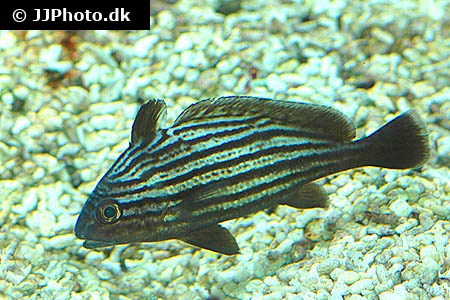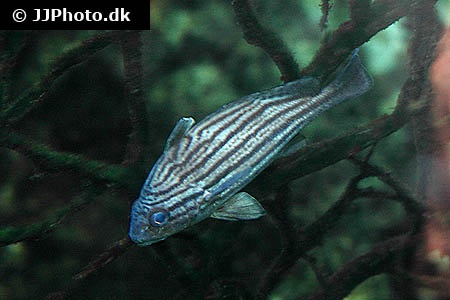Pareques acuminatus


| Latin name | Pareques acuminatus - (Bloch & Schneider, 1801) |
|---|---|
| Local name | High-hat |
| Family | Sciaenidae - Pareques |
| Origin | The Mexican Golf, West Atlantic |
| Max length | 23 cm (9.1") |
| Minimum volume |
700 l (185 gal) |
|---|---|
| Hardiness |
Average |
| Suitable for aquarium |
Suitable with care |
| Reef safe |
Reef safe with caution |
| Aggressiveness | Docile |
| Recommended |
Larger crustaceans (Shrimp, crabs...) Small crustaceans (Krill, mysis, artemia...) Zooplankton (Cyclops, pods...) |
|---|---|
| Mostly |
Fish Other invertebrates |
This spicies might be a threat to smaller fishes.
This species poses a threat towards shrimps and crabs etc., which are relatively small.
There is little available knowledge of this species, so there can be important information missing on this page.
This species searches through the sand for food, which can make the water cloudy and shakes up detritus.
In an aquarium their natural food source in the sand is quickly exhausted.
These fish are very difficult to feed, they demand live food, although occasionally they can get used to frozen foods. Live zooplankton (eg. Artemia or Mysis) or small living shrimps can be an excellent way to introduce them to eating in captivity.
They eat slowly and it can be a challenge to feed them if they are together with fish which eat the same food but are fast eaters.
This species is very sensitive during transportation and acclimatizing into the aquarium.
This species will better acclimatize to the aquarium`s condition if introduced, when young.
Very small individuals can be very delicate.
These fish may well hide themselves for a while, whilst getting acclimatized.
Do not disturb the fish while acclimating because it will prolong the process.
This species thrives best when there is a sufficiently large amount of micro life (copepods, amphipods or similar) in the aquarium, so that the it can always find their own food.
They can live as a pair provided they are introduced simultaneously.
This species needs good hiding places, for example, between live rocks.
This species is nocturnal and therefore the most active when the light is dimmed or turned off.
This species is very shy and docile, so one should be careful when keeping it with more aggressive fish.
Drums/Croakers (Sciaenidae) communicate with each other by making noises in the water, hence the name.
They will normally look for their food in the sand by digging it with their snout.
Drums/Croakers are easily stressed during transportation, even from one aquarium to the other. It can be difficult to get them to eat, and they should therefore not be kept with food competitors or aggressive species, as they will not get a sufficient amount of food.
They normally hide under overhangs or holes during the day and hunt at night.
| Aquarium trade | Yes |
|---|---|
| Distribution | Western Atlantic: North Carolina, USA to Rio de Janeiro, Brazil. Although reported from Bermuda by recent authors, this species is not native to the said country (Ref. 35505). |
| Danish common names |
Stribet trommefisk |
| English common names |
Streaked ribbonfish Donkey fish Cubbyu Highhat High-hat |
Scott W. Michael. 2004. Angelfishes and Butterflyfishes (Reef Fishes Series Book 3) TFH Publications / Microcosm Ltd. - (English)
Bob Fenner. Drums, Croakers: High Hats and Jackknifes, Family Sciaenidae - Wet Web Media - (English)
WWM Crew. FAQs about Croakers, Drums, Family Sciaenidae - Wet Web Media - (English)

